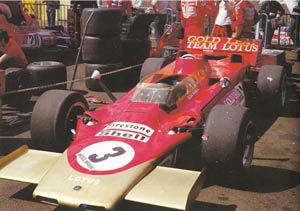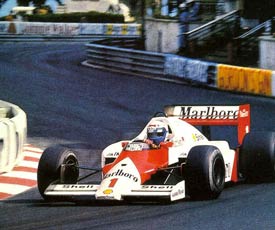 |
The F1 FAQ |
| by Mark Alan Jones, Australia | |
|
Have a question about Formula One statistics or history? Well you're not the only one, and it's about time someone came up with the answers to Formula One's most Frequently Asked Questions. Send us your questions, to faq@atlasf1.com - we may not know everything, but we will sure make the effort to find out
Testing and development of the car was carried out through the 1971 racing season, but towards the end of the season it was apparent that some of the car's problems could not be overcome. Development continued though at the Indy 500 where on the vast superspeedway it's characteristics were much less of a problem.
Reading from the official Telefonica-Minardi press statement, "Fondmetal purchased from Cosworth not only the rights to develop the project but also the support of key personnel and the equipment to produce and rebuild the 10-cylinder already fitted to the car last season. This engine, whose reliability was already proven last year, will benefit from two evolutions in the course of the 2000 season. Fondmetal is, therefore, looking forward to supplying a power-plant that will permit the Team to step forward in the constructors' chart."
That would seem to suggest it is the same engine as Minardi was using last year, and not the 1999 CR1 Stewart engine.
There is no real answer apart from 'they're the best'. But by the same token, they've also had the most committed manufacturers.
Honda returned to Formula One in the mid 80's and soon redefined the amount of money needed to be spent to make a winning engine. Honda spent a huge amount of money becoming a winner with Williams, and keeping the flow going at McLaren. Then when Honda started to lose interest Renault was spending the money needed to beat them. Now it's Mercedes.
Historically, Williams and McLaren have associated with the manufacturers most prepared (that doesn't mean the biggest budget) to win the world championship, despite the cost. Also Frank Williams and Ron Dennis have the leadership and ability to gather the best around them and get the best out of them.
At the principlaity the McLarens were too good and dominated the race. Senna faded and Mansell was just not quick enough. Nelson Piquet finished well down and the Ferraris were in no man's land. Piquet would finish seventh in his Williams ahead of the Arrows A8 BMW duo of Thierry Boutsen and Marc Surer, Stefano Johansson's Ferrari F186, Phillippe Strieff in the Tyrrell 015 Renault and the only other finisher was Jonathan Palmer in the Zakspeed 861.
Last week's Australian Grand Prix was in fact the 65th one. By now, it has been run at 24 different circuits, more so than any other national Grand Prix in the world.
It was first run in 1928 at the original Phillip Island circuit in Victoria, a circuit very different to the home of today's Australian Motorcylce Grand Prix. It was a handicap race and was won by Arthur Waite driving an Austin 7. The race was held annually, missing only 1938 and the years of World War II (1940-1946).
The race has been held at places such as Warwick Farm in New South Wales, the darling circuit of the Tasman Cup years of the 1960's when Formula One teams would travel from Europe; the giant and foreboding Lobethal in South Australia, possibly the world's fastest road circuit, where a 1.3 litre MG A was able to achieve a lap average of over 130 kilometres an hour for almost 22 hours in 1939; the much lamented Longford in Tasmania; the sweeps of Lakeside in Queensland; and of course, mighty Mount Panorama, Bathurst, where before the open wheelers were banned from the place you could, in the 1950's, see Formula One Ferraris, Maseratis, Alfa Romeos, Lago Talbots, Coopers, Altas and OSCAs skitter and dance where now Touring Cars fear to tread.
The race was won in its pre-World Championship era by names such as Peter Whitehead, Lex Davsion, Sir Jack Brabham, Sir Stirling Moss, Stan Jones, Bruce McLaren, Graham Hill, Jackie Stewart, Jim Clark, Chris Amon, Alan Jones, Roberto Moreno and Alain Prost.
The modern Albert Park, like Phillip Island not far to the south, is very different from the original circuit that hosted an Australian Grand Prix. The modern Albert Park uses some of the roads and streets of the original, but now runs in the opposite direction. Trees, guttering, poles, hay bales and spectators lined the circuit rather than armco or concrete. But it was a brilliant circuit, in some people's mind.
The first Albert Park meeting (of only a mere 6 at the original circuit) was the 1953 Australian Grand Prix, a race that was in effect dominated by Doug Whiteford's 4.5 litre Formula One Lago Talbot ahead of a group of MG based racers of varying specifications. The Australian Grand Prix returned to Albert Park in 1956 and was subject to an invasion by the visiting European teams. Sir Stirling Moss won the race from teammate Jean Behra in factory Maserati 250Fs ahead of British gentleman racer Peter Whitehead in a Ferrari Super Squalo. Reg Hunt, Stan Jones (Alan's father) and Reg Parnell completed the top six, all Maserati 250F mounted.
If you'd like more information I can thoroughly recommend the book "The official 50 year race history of the Australian Grand Prix" produced by Chevron Publishing Group and written by Graham Howard, Stewart Wilson, Ray Bell, Des White, Noel Tuckey, John Medley, Mark Durham and Terry Walker. It was published in 1986 so only includes up to the 1985 race, the first of the World Championship races.
|
| Mark Alan Jones | © 2000 Kaizar.Com, Incorporated. |
| Send questions and comments to: faq@atlasf1.com | Terms & Conditions |

